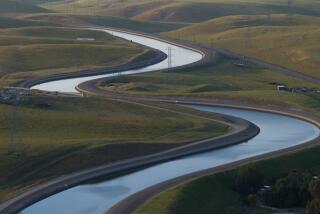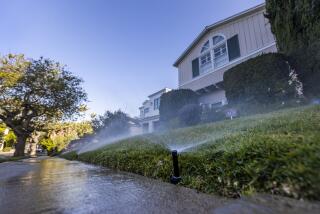Water Use Lower Than Before Drought : Conservation: Officials say they believe that most county residents will never return to previous unchecked consumption. But others feel that some mandatory limits are still needed.
- Share via
In the first months after the easing of penalties for excessive water use throughout much of Ventura County, consumption remains well below pre-drought levels, officials say.
While there has been some increase in consumption, officials last week said they believe that most county residents will never return to the kind of unchecked water use that marked public consumption habits before the drought hit California in 1986.
“I think most people have learned that water is a limited resource,” said Frank Brommenschenkel, manager of Santa Paula Water Works and president of the countywide Assn. of Water Agencies. “There could be a day when instead of a five-year drought there is a 10-year drought, and I think people realize that.”
But others caution that mandatory limits may have been lifted too soon. One good rain year may have ended the five-year drought locally, but a prolonged dry period could return, said Alisdair Coyne, a Ventura County environmentalist and professional landscape gardener.
“Some measure of mandatory conservation is necessary to keep it in people’s minds that what we had was just one good winter,” Coyne said. “But politicians like to make people think that they’ve done a good job and that everything is OK.”
Since the winter’s heavy rains, cities and water districts throughout Southern California and the county have backed away from strict conservation measures that were once enforced with stiff fines for violators.
In their place are a handful of ordinances that prohibit letting water run to waste and programs that offer rebates for installing low-flow fixtures. Most cities that had mandatory rationing have replaced penalty-enforced restrictions with calls for voluntary conservation of 5% to 10%.
Simi Valley, Thousand Oaks and Moorpark in the east county, along with Oxnard and Camarillo, followed the lead of the Metropolitan Water District of Southern California, which provides all or part of their water. MWD, which last year imposed penalties unless residents cut use by 20% from 1989 levels, removed all mandatory restrictions in April and now asks for voluntary 10% conservation.
Some cities in the county, including Port Hueneme, Santa Paula, Fillmore and Ojai, depend predominantly on local ground-water supplies and never had mandatory restrictions. Those cities now have calls for voluntary cuts.
Of all the cities in the county, only Ventura, which led the county in conservation efforts two years ago, retains any penalty-enforced restrictions. The city, which cut water use by 37% with mandatory rationing last year compared to 1989 levels, relaxed restrictions the first week in May from required 30% cuts down to about 20% cuts.
Shelley Jones, Ventura director of public works, said no water use figures are yet available for May, the first month since restrictions were relaxed. But he said water use remains low and he doubts that people will ever return to pre-drought use.
“With the consciousness level raised and the hardware in place, we will have a permanent 10% savings, and I think it will take us three or four years to get to that point,” Jones said.
Some residents agree that their water conservation habits are here to stay.
“It’s just second nature now,” said Mari Holden, 21, a college student who lives with her parents, Jim and Terri Holden, in northeast Ventura.
“We’ve made changes and it just isn’t that hard to do,” she said, referring to low-flow fixtures installed in the family home and a policy of shorter showers.
A few blocks away, Marge Thomas, a semi-retired interior decorator and artist, said she plans to increase her water use enough to bring back her lawn and trees that suffered during the drought.
She could have requested an additional allocation for fruit trees planted on her vacant hillside lot next to her own landscaped home. But she said she chose to stay within her allocation for a single house.
“I just didn’t think I should be sitting here in fat city while other people were struggling for enough water to take showers,” she said. “After all, how many peaches can you eat?”
In Camarillo, where restrictions were removed March 25, water use is up 9% for April over the same month in 1991. But it is still 13% less than in 1990, said John Elwell, the city’s director of community services.
“Our official goal is 10%, but I would encourage people to show me they can do 20%,” he said. “Most people can meet 20% conservation without seriously altering their lifestyles.”
The city of Oxnard has called on residents to cut water use by 5% from 1989 levels, easing off from 15% cutbacks required before the winter rains. The city met the 15% goal in April, 1991, and water use crept up about 1% this year.
“Our citizens have been fantastic about voluntarily conserving water,” said Michele Izay, the city’s water conservation manager. “They don’t want to go back to rationing.”
In Thousand Oaks, residents saved 30% overall last year when mandatory 20% cuts were in place. Restrictions were removed March 16, and consumption in April was 5% higher than in April, 1991. Residents are being asked to cut their water use by 10% from 1989 levels.
“Having been at 20% mandatory cutbacks, it won’t be hard for residents to achieve 10% voluntary cutbacks,” said Paul Swenson, water conservation coordinator for Thousand Oaks. “But it is important that we meet that 10%.”
In Simi Valley, restrictions requiring 20% cuts are expected to be lifted at Monday’s City Council meeting and replaced with 10% voluntary conservation, said Michael Kleinbrodt, deputy director of public works.
Despite the continuing penalties until June 1, Kleinbrodt said the city’s water use is up about 5% over last year, when residents saved 20%.
But he cautioned that dry periods will return to arid Southern California.
“If people get used to saving water as a way of life, it will be a lot easier on them to handle the next time,” he said.
In Santa Paula, where mandatory restrictions were never imposed, the city’s use is up about 5% over last year, when residents voluntarily saved nearly 14%. In Fillmore, residents saved 8% last year but no conservation figures for spring were available.
Farmers have also made permanent changes that will reduce their need for water, officials said. Huntsinger Ojai Ranches owner Carl Huntsinger said his operation may be able to cut water consumption up to 30% over last year through new technology.
Huntsinger’s ranches now use a system to evaluate soil before an orchard is watered. Clay soils that retain water need less irrigation than sandy soils that allow water to percolate through, he said.
More and more, he and other growers use calculations that measure air and ground moisture and prevailing winds to determine how much water should be used, he said.
“Farmers have really begun to realize that water is a valuable resource,” Huntsinger said. “I don’t think the water shortage is over. And if you take a short-term view that we’ve got plenty of water to use this year, I think you’re kidding yourself.”
Supervisor John K. Flynn, considered an expert on water issues, said cities and water districts should continue to pay rebates for low-flow fixtures and encourage if not require at least 15% conservation.
“We should continue down the same path we were on, easing up a little, but not much,” he said. “Just because we had a nice rain doesn’t mean we have an adequate water supply for the future.”
More to Read
Sign up for Essential California
The most important California stories and recommendations in your inbox every morning.
You may occasionally receive promotional content from the Los Angeles Times.










